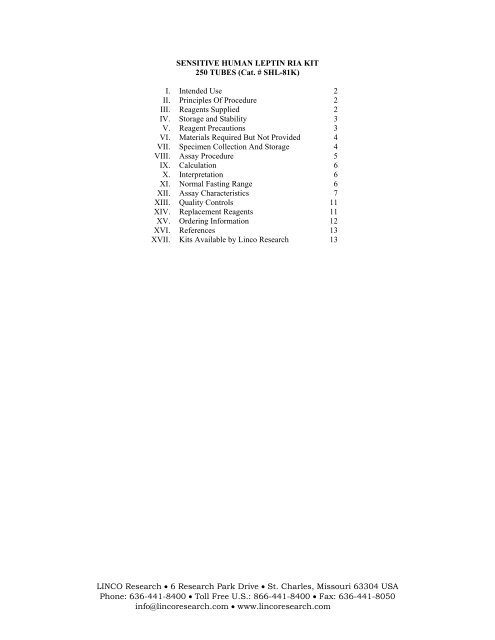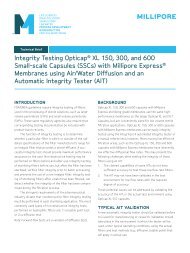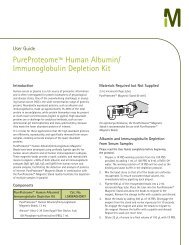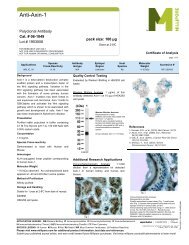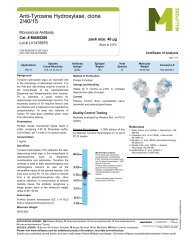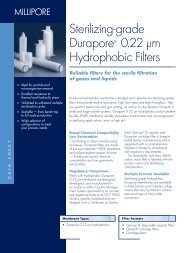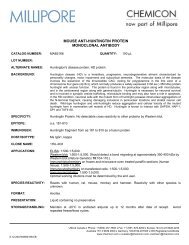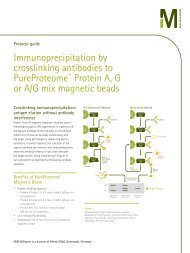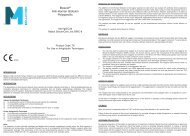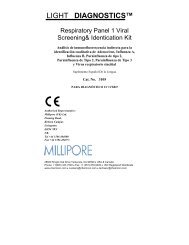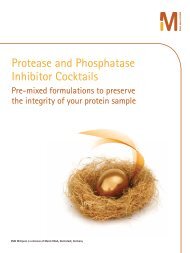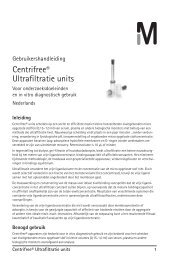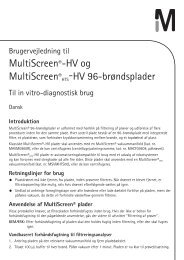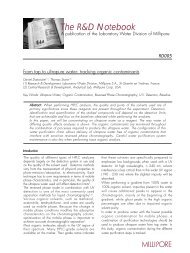LINCO Research • 6 Research Park Drive • St. Charles ... - Millipore
LINCO Research • 6 Research Park Drive • St. Charles ... - Millipore
LINCO Research • 6 Research Park Drive • St. Charles ... - Millipore
You also want an ePaper? Increase the reach of your titles
YUMPU automatically turns print PDFs into web optimized ePapers that Google loves.
SENSITIVE HUMAN LEPTIN RIA KIT<br />
250 TUBES (Cat. # SHL-81K)<br />
I. Intended Use 2<br />
II. Principles Of Procedure 2<br />
III. Reagents Supplied 2<br />
IV. <strong>St</strong>orage and <strong>St</strong>ability 3<br />
V. Reagent Precautions 3<br />
VI. Materials Required But Not Provided 4<br />
VII. Specimen Collection And <strong>St</strong>orage 4<br />
VIII. Assay Procedure 5<br />
IX. Calculation 6<br />
X. Interpretation 6<br />
XI. Normal Fasting Range 6<br />
XII. Assay Characteristics 7<br />
XIII. Quality Controls 11<br />
XIV. Replacement Reagents 11<br />
XV. Ordering Information 12<br />
XVI. References 13<br />
XVII. Kits Available by Linco <strong>Research</strong> 13<br />
<strong>LINCO</strong> <strong>Research</strong> <strong>•</strong> 6 <strong>Research</strong> <strong>Park</strong> <strong>Drive</strong> <strong>•</strong> <strong>St</strong>. <strong>Charles</strong>, Missouri 63304 USA<br />
Phone: 636-441-8400 <strong>•</strong> Toll Free U.S.: 866-441-8400 <strong>•</strong> Fax: 636-441-8050<br />
info@lincoresearch.com <strong>•</strong> www.lincoresearch.com
I. INTENDED USE<br />
SENSITIVE HUMAN LEPTIN RIA KIT<br />
250 TUBES (Cat. # SHL-81K)<br />
This Sensitive Human Leptin Radioimmunoassay (RIA) Kit utilizes an antibody made specifically against Human Leptin.<br />
Sensitivity of 0.05 ng/ml can be achieved when using a 100 µl sample of serum, plasma, or tissue culture media, in a twoday,<br />
disequilibrium assay (400 µl Total Volume). This kit is for research purposes only.<br />
II. PRINCIPLES OF PROCEDURE<br />
In radioimmunoassay, a fixed concentration of labeled tracer antigen is incubated with a constant dilution of antiserum such<br />
that the concentration of antigen binding sites on the antibody is limited, for example, only 50% of the total tracer<br />
concentration may be bound by antibody. If unlabeled antigen is added to this system, there is competition between labeled<br />
tracer and unlabeled antigen for the limited and constant number of binding sites on the antibody. Thus, the amount of tracer<br />
bound to antibody will decrease as the concentration of unlabeled antigen increases. This can be measured after separating<br />
antibody-bound from free tracer and counting one or the other, or both fractions. A calibration or standard curve is set up<br />
with increasing concentrations of standard unlabeled antigen and from this curve the amount of antigen in unknown samples<br />
can be calculated. Thus, the four basic necessities for a radioimmunoassay system are: a specific antiserum to the antigen to<br />
be measured, the availability of a radioactive labeled form of the antigen, a method whereby antibody-bound tracer can be<br />
separated from the unbound tracer, and finally, an instrument to count radioactivity.<br />
The Linco <strong>Research</strong> Sensitive Human Leptin assay utilizes 125 I-labeled Human Leptin and a Sensitive Human Leptin<br />
antiserum to determine the level of Leptin in serum, plasma or tissue culture media by the double antibody/PEG technique.<br />
III. REAGENTS SUPPLIED<br />
Each kit is sufficient to run 250 tubes and contains the following reagents.<br />
A. Assay Buffer<br />
0.05M Phosphosaline pH 7.4 containing 0.025M EDTA, 0.08% Sodium Azide, 1% RIA Grade BSA and<br />
0.05% Triton X-100<br />
Quantity: 40 ml/vial<br />
Preparation: Ready to use<br />
B. Antiserum<br />
Guinea Pig anti-Sensitive Human Leptin Serum in Assay Buffer<br />
Quantity: 26 ml/vial<br />
Preparation: Ready to use<br />
C.<br />
125 I-Human Leptin<br />
125 I-Human Leptin Label, HPLC purified (specific activity 135 µCi/µg)<br />
Lyophilized for stability. Freshly iodinated label contains
III. REAGENTS SUPPLIED (continued)<br />
E. <strong>St</strong>andards<br />
Purified Recombinant Human Leptin in Assay Buffer at the following concentrations:<br />
0.05, 0.1, 0.2, 0.5, 1.0, 2.0, 5.0, 10.0 ng/ml<br />
Quantity: 1 ml/vial<br />
Preparation: Ready to use<br />
F. Quality Controls 1 & 2<br />
Purified Recombinant Human Leptin in Assay Buffer<br />
Quantity: 1 ml/vial<br />
Preparation: Ready to use<br />
G. Precipitating Reagent<br />
Goat anti-Guinea Pig IgG serum, 3% PEG and 0.05% Triton X-100 in 0.05M Phosphosaline, 0.025M EDTA,<br />
0.08% Sodium Azide<br />
Quantity: 260 ml/vial<br />
Preparation: Ready to use; chill to 4°C.<br />
IV. STORAGE AND STABILITY<br />
Refrigerate all reagents between 2 and 8°C for short-term storage. For prolonged storage (>2 weeks), freeze at<br />
≤ -20°C. Avoid multiple (>5) freeze/thaw cycles. Refer to date on bottle for expiration when stored at ≤ -20°C. Do<br />
not mix reagents from different kits unless they have the same lot number.<br />
V. REAGENT PRECAUTIONS<br />
A. Radioactive Materials<br />
This radioactive material may be received, acquired, possessed and used only by research personnel or clinical<br />
laboratories for in vitro research tests not involving internal or external administration of the material, or the radiation<br />
there from, to human beings or animals. Its receipt, acquisition, possession, use and transfer are subject to the<br />
regulations of the U. S. Nuclear Regulatory Commission (NRC) or of a <strong>St</strong>ate with which the Commission has entered<br />
into an agreement for the exercise of regulatory authority.<br />
The following are suggested general rules for the safe use of radioactive material. The customer’s Radiation Safety<br />
Officer (RSO) is ultimately responsible for the safe handling and use of radioactive material.<br />
1. Wear appropriate personal devices at all times while in areas where radioactive materials are used or stored.<br />
2. Wear laboratory coats, disposable gloves, and other protective clothing at all times.<br />
3. Monitor hands, shoes, and clothing and immediate area surrounding the workstation for contamination after each<br />
procedure and before leaving the area.<br />
4. Do not eat, drink, or smoke in any area where radioactive materials are stored or used.<br />
5. Never pipette radioactive material by mouth.<br />
6. Dispose of radioactive waste in accordance with NRC rules and regulations.<br />
7. Avoid contaminating objects such as telephones, light switches, doorknobs, etc.<br />
8. Use absorbent pads for containing and easily disposing of small amounts of contamination.<br />
9. Wipe up all spills immediately and thoroughly and dispose of the contaminated materials as radioactive waste. Inform<br />
Radiation Safety Officer.<br />
SHL-81K-Rev 01/19/04 <strong>LINCO</strong> <strong>Research</strong> 3
V. REAGENT PRECAUTIONS (continued)<br />
B. Sodium Azide<br />
Sodium Azide has been added to all reagents as a preservative at a concentration of 0.08%. Although it is at a<br />
minimum concentration, Sodium Azide may react with lead and copper plumbing to form highly explosive metal<br />
azides. On disposal, flush with a large volume of water to prevent azide build up.<br />
VI. MATERIALS REQUIRED BUT NOT PROVIDED<br />
1. Borosilicate glass tubes, 12 x 75 mm. (NOTE: Polypropylene or polystyrene tubes may be used if the investigator<br />
finds that the pellet formation is acceptably stable in their system.)<br />
2. 100 µl pipet with disposable tips<br />
3. 100 µl & 1.0 ml repeating dispenser<br />
4. Refrigerated swing bucket centrifuge capable of developing 2,000 - 3,000 xg. (Use of fixed-angle buckets are not<br />
recommended.)<br />
5. Absorbent paper<br />
6. Vortex mixer<br />
7. Refrigerator<br />
8. Gamma Counter<br />
VII. SPECIMEN COLLECTION AND STORAGE<br />
1. A maximum of 100 µl per assay tube of serum or plasma can be used, although, 50 µl per assay tube is adequate for<br />
most applications. Tissue culture and other media may also be used.<br />
2. Care must be taken when using heparin as an anticoagulant, since an excess will provide falsely high values. Use no<br />
more than 10 IU heparin per ml of blood collected.<br />
3. Specimens can be stored at 4°C if they will be tested within 24 hours of collection. For longer storage, specimens<br />
should be stored at ≤ -20°C. Avoid multiple (>5) freeze/thaw cycles.<br />
4. Avoid using samples with gross hemolysis or lipemia.<br />
SHL-81K-Rev 01/19/04 <strong>LINCO</strong> <strong>Research</strong> 4
VIII. ASSAY PROCEDURE<br />
For optimal results, accurate pipetting and adherence to the protocol are recommended.<br />
Day One<br />
1. Pipette 300 µl of Assay Buffer to the Non-Specific Binding (NSB) tubes (3-4). Pipette 200 µl of Assay Buffer in the<br />
Reference (Bo) tubes (5-6). Pipette 100 µl of Assay Buffer to tubes seven through the end of the assay.<br />
2. Pipette 100 µl of <strong>St</strong>andards and Quality Controls in duplicate (see assay flow chart).<br />
3. Pipette 100 µl of each sample in duplicate. (NOTE: Smaller volumes of sample may be used when Leptin concentrations<br />
are anticipated to be elevated or when sample size is limited. Additional Assay Buffer should be added to compensate for<br />
the difference so that the volume is equivalent to 100 µl (e.g., when using 50 µl of sample, add 50 µl of Assay Buffer).<br />
Refer to Section IX for calculation modification.<br />
4. Pipette 100 µl of Sensitive Human Leptin Antibody to all tubes except Total Count tubes (1-2) and NSB tubes (3-4).<br />
5. Vortex, cover, and incubate overnight (20-24 hours) at room temperature.<br />
Day Two<br />
6. Pipet 100 µl of 125 I-Human Leptin tracer to all tubes. Important: For preparation, see Section III, Part C.<br />
7. Vortex, cover, and incubate overnight (22-24 hours) at room temperature.<br />
Day Three<br />
8. Add 1.0 ml of cold (4°C) Precipitating Reagent to all tubes except Total Count tubes (1-2).<br />
9. Vortex and incubate 20 minutes at 4°C.<br />
10. Centrifuge, at 4°C, for 20 minutes at 2,000-3,000 xg. Note: If less than 2,000 xg is used, the time of<br />
centrifugation must be increased to obtain a firm pellet (e.g. 40 minutes). Multiple centrifuge runs within an assay must be<br />
consistent. Conversion of rpm to xg:<br />
xg = (1.12 x 10 -5 ) (r) (rpm) 2<br />
r = radial distance in cm (from axis of rotation to the bottom of the tube)<br />
rpm = revolutions per minute<br />
11. Immediately decant supernatant from all centrifuged tubes except Total Count tubes (1-2). Drain tubes for 15-60 seconds (be<br />
consistent between racks), and blot excess liquid from lip of tubes. Note: Invert tubes only one time. Pellets are fragile and<br />
slipping may occur.<br />
12. Count all tubes in a gamma counter for 1 minute. Calculate the ng/ml of Sensitive Human Leptin in unknown samples<br />
using automated data reduction procedures (see Section IX).<br />
Assay Procedure Flow Chart<br />
Day One Day Two Day Three<br />
Set-up <strong>St</strong>ep 1 <strong>St</strong>ep 2&3 <strong>St</strong>ep 4 <strong>St</strong>ep 5 <strong>St</strong>ep 6 <strong>St</strong>ep 7 <strong>St</strong>ep 8 <strong>St</strong>eps 9-12<br />
Tube<br />
Number<br />
Add<br />
Assay<br />
Buffer<br />
Add <strong>St</strong>andard/QC<br />
Sample<br />
Add<br />
Sensitive<br />
Human<br />
Leptin<br />
Antibody<br />
Vortex,<br />
Cover, and<br />
Incubate 20-<br />
24 hrs at RT<br />
Add I-125<br />
Human<br />
Leptin Tracer<br />
Vortex,<br />
Cover and<br />
Incubate<br />
22-24 hrs<br />
at RT<br />
Add Precipitating<br />
Reagent<br />
1,2 - - - 100 µl -<br />
3,4 300 µl - - 100 µl 1.0 ml<br />
5,6 200 µl - 100 µl 100 µl 1.0 ml<br />
7,8 100 µl 100 µl of 0.05 ng/ml 100 µl 100 µl 1.0 ml<br />
9,10 100 µl 100 µl of 0.1 ng/ml 100 µl 100 µl 1.0 ml<br />
11,12 100 µl 100 µl of 0.2 ng/ml 100 µl 100 µl 1.0 ml<br />
13,14 100 µl 100 µl of 0.5 ng/ml 100 µl 100 µl 1.0 ml<br />
15,16 100 µl 100 µl of 1.0 ng/ml 100 µl 100 µl 1.0 ml<br />
17,18 100 µl 100 µl of 2.0 ng/ml 100 µl 100 µl 1.0 ml<br />
19,20 100 µl 100 µl of 5.0 ng/ml 100 µl 100 µl 1.0 ml<br />
21,22 100 µl 100 µl of 10.0 ng/ml 100 µl 100 µl 1.0 ml<br />
23,24 100 µl 100 µl of QC 1 100 µl 100 µl 1.0 ml<br />
25,26 100 µl 100 µl of QC 2 100 µl 100 µl 1.0 ml<br />
27,28 100 µl 100 µl of unknown 100 µl 100 µl 1.0 ml<br />
Incubate 20 min.<br />
at 4°C, Centrifuge<br />
at 4°C for 20 min<br />
Decant and Count<br />
SHL-81K-Rev 01/19/04 <strong>LINCO</strong> <strong>Research</strong> 5
IX. CALCULATIONS AND TRANSFORMATIONS<br />
A. Explanation<br />
The calculations for Sensitive Human Leptin can be automatically performed by most gamma counters possessing data<br />
reduction capabilities or by independent treatment of the raw data using a commercially available software package 5 .<br />
Choose weighted 4-parameter or weighted log/logit for the mathematical treatment of the data. [NOTE: Be certain the<br />
procedure used subtracts the NSB counts from each average count, except Total Counts, prior to final data reduction.]<br />
B. Manual Calculation<br />
1. Average duplicate counts for Total Count tubes (1-2), NSB tubes (3-4), Total Binding tubes (reference, Bo) (5-6), and<br />
all duplicate tubes for standards and samples to the end of the assay.<br />
2. Subtract the average NSB counts from each average count (except for Total Counts). These counts are used in the<br />
following calculations.<br />
3. Calculate the percentage of tracer bound<br />
[(Total Binding Counts/Total Counts) X 100].<br />
This should be 35-50%.<br />
4. Calculate the percentage of total binding (%B/Bo) for each standard and sample<br />
[%B/Bo = (Sample or <strong>St</strong>andard/Total Binding) X 100]<br />
5. Plot the % B/Bo for each standard on the y-axis and the known concentration of the standard on the x-axis. The use of<br />
log-log graph paper will result in a nearly linear curve.<br />
6. Construct the reference curve by joining the points with a smooth curve.<br />
7. Determine the ng/ml of Sensitive Human Leptin in the unknown samples and controls by interpolation of the reference<br />
curve.<br />
[NOTE: When sample volumes assayed differ from 100 µl, an appropriate mathematical adjustment must be made to<br />
accommodate for the dilution factor (e.g., if 50 µl of sample is used, then calculated data must be multiplied by 2).]<br />
X. INTERPRETATION<br />
A. Acceptance Criteria<br />
1. The run will be considered accepted when all Quality Control values fall within the calculated Quality<br />
Control Range; if any QC’s fall outside the control range, review results with the supervisor.<br />
2. If the difference between duplicate results of a sample is >10% CV, repeat the sample.<br />
3. The limit of sensitivity for the Sensitive Human Leptin assay is 0.05 ng/ml (100 µl sample size).<br />
4. The limit of linearity for the Sensitive Human Leptin assay is 10.0 ng/ml (100 µl sample size). Any result greater than<br />
10.0 ng/ml should be repeated on dilution using Assay Buffer as a diluent.<br />
XI. NORMAL FASTING RANGE<br />
Leptin levels are directly correlated with degree of adiposity.<br />
Mean Leptin Values (BMI ranges 18-25):<br />
Lean Men 3.8 ± 1.8 ng/ml<br />
Lean Women 7.4 ± 3.7 ng/ml<br />
Levels rise approximately 2.5 times faster in women per unit BMI as compared to men.<br />
SHL-81K-Rev 01/19/04 <strong>LINCO</strong> <strong>Research</strong> 6
XII. ASSAY CHARACTERISTICS<br />
A. Sensitivity<br />
The lowest level of Leptin that can be detected by this assay is 0.05 ng/ml when using a 100 µl sample size.<br />
B. Performance<br />
The following parameters of assay performance are expressed as Mean ± <strong>St</strong>andard Deviation.<br />
ED80 = 0.28 ± 0.04 ng/ml<br />
ED50 = 1.05 ± 0.12 ng/ml<br />
ED20 = 4.48 ± 0.66 ng/ml<br />
C. Specificity<br />
The specificity (also known as selectivity) of an analytical test is its ability to selectively measure the analyte in the<br />
presence of other like components in the sample matrix.<br />
Human Leptin 100%<br />
Rat Leptin < 1%<br />
Mouse Leptin < 2%<br />
Canine Leptin < 0.2%<br />
Human Insulin *<br />
Glucagon *<br />
*not detectable<br />
D. Precision<br />
Within and Between Assay Variation<br />
Sample Mean Within Between<br />
No. ng/ml % CV % CV<br />
1 0.44 5.25 8.90<br />
2 0.92 3.74 3.47<br />
3 1.50 5.69 3.24<br />
4 3.14 7.48 4.02<br />
5 4.24 5.97 8.67<br />
Within and between assay variation was performed on five human serum samples containing varying<br />
concentrations of Human Leptin. Data (mean and % CV) shown are from five duplicate determinations of<br />
each serum sample in five separate assays.<br />
SHL-81K-Rev 01/19/04 <strong>LINCO</strong> <strong>Research</strong> 7
XII. ASSAY CHARACTERISTICS (continued)<br />
E. Recovery<br />
Spiking Recovery of Leptin in Human Serum<br />
Sample<br />
No.<br />
Leptin<br />
Added<br />
ng/ml<br />
Observed<br />
ng/ml<br />
Expected<br />
ng/ml<br />
%<br />
Recovery<br />
1 0 0.30 - -<br />
2 0.2 0.52 0.50 104<br />
3 0.5 0.85 0.80 106<br />
4 1.0 1.50 1.30 115<br />
5 2.0 2.72 2.30 118<br />
Varying concentrations of Human Leptin were added to five human serum samples and the leptin content was<br />
determined by RIA. Mean of the observed levels from five duplicate determinations in five separate assays are<br />
shown. Percent recovery was calculated on the observed vs. expected.<br />
F. Linearity<br />
Effect of Serum Dilution<br />
Sample Volume Observed Expected % Of<br />
# Sampled ng/ml ng/ml Expectd<br />
1 100 µl 1.07 1.07 100<br />
75 µl 0.99 93<br />
50 µl 0.88 82<br />
25 µl 0.78 73<br />
2 100 µl 2.07 2.07 100<br />
75 µl 2.00 97<br />
50 µl 1.85 89<br />
25 µl 1.50 72<br />
3 100 µl 3.14 3.14 100<br />
75 µl 3.06 97<br />
50 µl 3.05 97<br />
25 µl 2.54 81<br />
4 100 µl 4.24 4.24 100<br />
75 µl 4.34 102<br />
50 µl 4.42 104<br />
25 µl 4.05 96<br />
Aliquots of pooled human serum containing varying concentrations of Leptin were analyzed in the volumes indicated.<br />
Dilution factors of 1.0, 1.33, 2.0 and 4.0 representing 100 µl, 75 µl, 50 µl and 25 µl, respectively, were applied in<br />
calculating observed concentrations. Mean Leptin levels and percent of expected for five separate assays are shown.<br />
SHL-81K-Rev 01/19/04 <strong>LINCO</strong> <strong>Research</strong> 8
XII. ASSAY CHARACTERISTICS (continued)<br />
G. Correlation Between Linco Kits<br />
Comparison of Human Serum Leptin Analyzed by Human Leptin RIA kit (Cat. # HL-81K) and Sensitive<br />
Human Leptin RIA kit (Cat. # SHL-81K).<br />
Lept in (ng/ mL)<br />
Sen sitive RIA Kit, Cat. # SHL-81K<br />
90<br />
80<br />
70<br />
60<br />
50<br />
40<br />
30<br />
20<br />
10<br />
°<br />
° °<br />
°<br />
°<br />
°<br />
°<br />
°<br />
°<br />
°<br />
°<br />
° °° °<br />
°<br />
°<br />
°<br />
° °<br />
°<br />
° °<br />
°<br />
° °<br />
°<br />
°<br />
°<br />
°<br />
°<br />
10<br />
20<br />
30<br />
°<br />
°<br />
40<br />
° °<br />
Y = 1.04X + 0.68<br />
Y = 1.04X + 0.68<br />
r = 0.985<br />
r = 0.985<br />
50<br />
°<br />
60<br />
Leptin (ng/ mL)<br />
RIA Kit, Cat. # HL-81K<br />
70<br />
SHL-81K-Rev 01/19/04 <strong>LINCO</strong> <strong>Research</strong> 9<br />
80<br />
°<br />
90
XII. ASSAY CHARACTERISTICS (continued)<br />
H. Example of Assay Results<br />
This data is presented as an example only and should<br />
not be used in lieu of a standard curve prepared<br />
with each assay.<br />
Tube #<br />
ID<br />
CPM<br />
Ave CPM<br />
Ave Net CPM<br />
% B/Bo<br />
1 Totals 18253<br />
2 ″ 22772 20513<br />
3 NSB 618<br />
4 ″ 648 633<br />
5 Bo 9523<br />
6 ″ 9472 9498 8865<br />
<strong>St</strong>andards<br />
7 0.05 ng/ml 9134<br />
8 9011 9073 8440 95.2<br />
9 0.1 ng/ml 8777<br />
10 8704 8741 8108 91.5<br />
11 0.2 ng/ml 8220<br />
12 8227 8224 7591 85.6<br />
13 0.5 ng/ml 6692<br />
14 6664 6678 6045 68.2<br />
15 1.0 ng/ml 5024<br />
16 5135 5080 4447 50.2<br />
17 2.0 ng/ml 3390<br />
18 3310 3350 2717 30.7<br />
19 5.0 ng/ml 2325<br />
20 2236 2281 1648 18.6<br />
21 10.0 ng/ml 1908<br />
22 1904 1906 1273 14.4<br />
Controls/Unknown<br />
SHL-81K-Rev 01/19/04 <strong>LINCO</strong> <strong>Research</strong> 10<br />
ng/ml<br />
23 QC 1 7701<br />
24 7378 7540 6907 77.9 0.27<br />
25 QC 2 3456<br />
26 3391 3424 2791 31.5 2.39<br />
27-n Unknown
XIII. QUALITY CONTROLS<br />
Good Laboratory Practice (GLP) requires that Quality Control (QC) specimens be run with each standard curve to check the<br />
assay performance. Two levels of controls are provided for this purpose. These and any other control materials should be<br />
assayed repeatedly to establish mean values and acceptable ranges. Each individual laboratory is responsible for defining<br />
their system for quality control decisions and is also responsible for making this system a written part of their laboratory<br />
manual.<br />
Recommended batch analysis decision using two controls (Westgard Rules) 6 :<br />
1. When both controls are within ±2 SD. Decision: Approve batch and release analyte results.<br />
2. When one control is outside ±2 SD and the second control is within ±2 SD.<br />
Decision: Hold results, check with supervisor. If no obvious source of error is identified by the below mentioned<br />
check of systems, the supervisor may decide to release the results.<br />
Technician check of systems:<br />
1. Check for calculation errors<br />
2. Repeat standards and controls<br />
3. Check reagent solutions<br />
4. Check instrument<br />
XIV. REPLACEMENT REAGENTS<br />
Reagents Cat #<br />
125 I-Human Leptin (
XV. ORDERING INFORMATION<br />
A. To place an order:<br />
For USA Customers:<br />
Please provide the following information to our customer service department to expedite your telephone, fax or<br />
mail order:<br />
1. Your name, telephone and/or fax number<br />
2. Customer account number<br />
3. Shipping and billing address<br />
4. Purchase order number<br />
5. Catalog number and description of product<br />
6. Quantity and product size<br />
NOTE: Appropriate license from NRC (or equivalent) must be on file at <strong>LINCO</strong> before radioactive orders<br />
can be shipped.<br />
TELEPHONE ORDERS:<br />
Toll free US (866) 441-8400<br />
(636) 441-8400<br />
FAX ORDERS: (636) 441-8050<br />
MAIL ORDERS: <strong>LINCO</strong> <strong>Research</strong><br />
6 <strong>Research</strong> <strong>Park</strong> <strong>Drive</strong><br />
<strong>St</strong>. <strong>Charles</strong>, Missouri 63304 U.S.A.<br />
For International Customers:<br />
To best serve our international customers, it is <strong>LINCO</strong>’s policy to sell our products only through a network of<br />
distributors. To place an order or to obtain additional information about <strong>LINCO</strong> products, please contact your local<br />
distributor.<br />
B. Conditions of Sale<br />
All products are for research or manufacturing use only. They are not intended for use in clinical diagnosis or for<br />
administration to humans or animals. All products are intended for in vitro use only.<br />
C. Terms<br />
Invoices are net 30 days in U.S. dollars. Prices are subject to change without notice.<br />
D Material Safety Data Sheets (MSDS)<br />
Material safety data sheets for <strong>LINCO</strong> <strong>Research</strong> products may be ordered by fax or phone. See section A above for<br />
details on ordering.<br />
SHL-81K-Rev 01/19/04 <strong>LINCO</strong> <strong>Research</strong> 12
XVI. REFERENCES<br />
1. Pelleymounter, M.A., et. al. Effects of the Obese Gene Product on Body Weight Regulation in Ob/ob Mice. Science.<br />
269:540-543, 1995.<br />
2. Maffei, M., et. al. Leptin Levels in Human and Rodent: Measurement of Plasma Leptin and ob RNA in Obese and<br />
Weight-reduced Subjects. Nature Med. Vol. 1, 11:1155-1611, 1995.<br />
3. Ma, Zhongmin, et al. Radioimmunoassay of Leptin in Human Plasma. Clinical Chemistry. 42:942-946, June, 1996.<br />
4. Thorell, J.I. Scand. J. Clin. Lab. Invest. 31:187, 1973.<br />
5. Feldman, H. and Rodbard, D. “Mathematical Theory of Radioimmunoassay”, in:W.D Odell and Doughaday, W.H.<br />
(Ed.), Principles of Competitive Protein-Binding Assays. Philadelphia: J.B. Leppincott Company; pp 158-203, 1971.<br />
6. Westgard, J.O., et. al. A Multi-rule Shewhart Chart for Quality Control in Clinical Chemistry. Clin. Chem. 27:493-<br />
501, 1981.<br />
XVII. KITS AVAILABLE FROM <strong>LINCO</strong> RESEARCH<br />
Radioimmunoassays:<br />
Human Leptin Ultra Sensitive Human Insulin<br />
Sensitive Human Leptin Human Proinsulin<br />
Mouse Leptin Canine C-Peptide<br />
Multi Species Leptin Human C-Peptide<br />
Rat Leptin Porcine C-Peptide<br />
Primate Leptin Rat C-Peptide<br />
Rat Insulin Glucagon<br />
Sensitive Rat Insulin Glucagon Like Peptide-1 (Total)<br />
Porcine Insulin Glucagon Like Peptide-1 (Active)<br />
Lispro Insulin Rat Growth Hormone<br />
Human Insulin Specific Porcine/Canine Growth Hormone<br />
Mouse Adiponectin Human Adiponectin<br />
Human Ghrelin (Total) Human Ghrelin (Active)<br />
Mouse Resistin Human PYY (Total)<br />
ELISAs:<br />
Human Amylin (Active) Human Leptin<br />
Human Amylin (Total) Glucagon Like Peptide-1 (Active)<br />
Human Insulin Human C-Peptide<br />
Rat/Mouse Insulin Human Resistin<br />
Mouse Adiponectin Human Adiponectin<br />
Human Proinsulin (Total) Human Proinsulin (Intact)<br />
Desacyl-Ghrelin Active Ghrelin<br />
SHL-81K-Rev 01/19/04 <strong>LINCO</strong> <strong>Research</strong> 13
XVII. KITS AVAILABLE FROM <strong>LINCO</strong> RESEARCH (continued)<br />
Multiplex:<br />
Human Cytokine (IL-1 α, IL-1β, IL-2, IL-4, IL-5, IL-6, IL-7. IL-8, IL-10, IL-12(p70), IL-13, IL-15,<br />
IL-17, IFNγ, GM-CSF, TNFα, IP-10, G-CSF, Eotaxin, MCP-1, MIP-1α, RANTES), Premixed<br />
Mouse Cytokine (IL-1α, IL-1β, IL-2, IL-4, IL-5, IL-6, IL-7, IL-9, IL-10, IL-12(p70), IL-13, IL-15, IL-17,<br />
IFNγ, IP-10, G-CSF, GMCSF, TNFα, MIP-1α, MCP-1, KC, RANTES), Premixed<br />
Rat Cytokine (IL-1β, IL-4, IL-6, IL-10, IFNγ, GRO-KC, TNFα, GM-CSF, IL-1α, MCP-1, IL-2, IL-12,<br />
IL-5, IL-18), Premixed<br />
Human Endocrine (Leptin, GLP-1, C-Peptide, Insulin, Glucagon, Amylin (Total), Amylin (Active)<br />
Rat Endocrine (Insulin, Amylin, Leptin, Glucagon, GLP-1, )<br />
Mouse Endocrine (Insulin, Amylin, Leptin, Glucagon, GLP-1)<br />
Apolipoproteins (Apo AI, Apo AII, Apo B, Apo CII, Apo CIII, Apo E)<br />
Mouse Adipokine (Insulin, MCP-1, Leptin, IL-6, TNFα, tPAI-1, Resistin)<br />
Mouse Adipocyte (MCP-1, Leptin, IL-6, TNFα, tPAI-1, Resistin, Adiponectin)<br />
Single plex:<br />
Human Cytokine (IL-10, TNFα, RANTES)<br />
Mouse Cytokine (TNFα)<br />
Mouse Adipokine (Adiponectin)<br />
SHL-81K-Rev 01/19/04 <strong>LINCO</strong> <strong>Research</strong> 14


